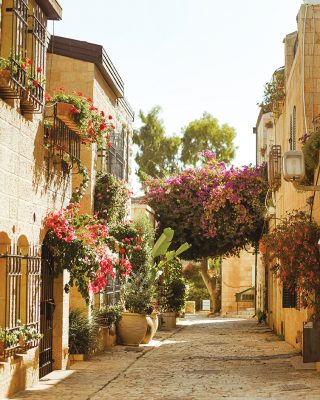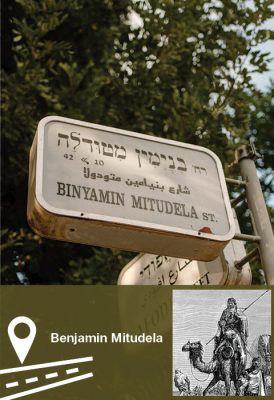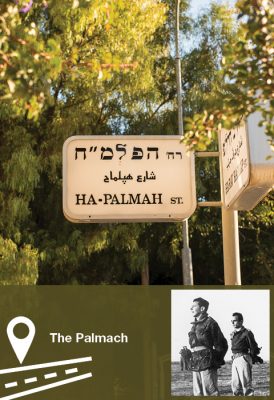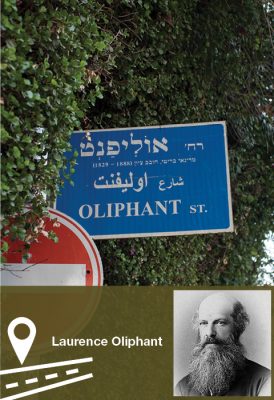×


We have detected your country as:
Please click here to go to the USA website or select another country from the dropdown list.
by: Nathan Williams, Director of Marketing and Communications
 Journeying along the streets of Jerusalem is like paging through an encyclopedia filled with a rich and vibrant history. Jerusalem does not have regular street names like Maple, Magnolia or Main. Rather, at every turn, the events and people who were influential in the history of the Jewish people or in the creation of the modern State of Israel are now immortalized in the names of the thoroughfares that crisscross the City of Gold.
Journeying along the streets of Jerusalem is like paging through an encyclopedia filled with a rich and vibrant history. Jerusalem does not have regular street names like Maple, Magnolia or Main. Rather, at every turn, the events and people who were influential in the history of the Jewish people or in the creation of the modern State of Israel are now immortalized in the names of the thoroughfares that crisscross the City of Gold.
It is a rarity to find streets named for former US presidents or British prime ministers in the capital cities of the Middle East. Jerusalem, however, honors those foreign leaders who have in one way or another left an impact on the Jewish people. Washington Street recognizes George Washington, the first US president, as a friend of the Jewish people and a champion for religious tolerance. Writing in 1730 to the president of a Jewish congregation in Rhode Island, Washington said: “May the Children of the Stock of Abraham, who dwell in this land, continue to merit and enjoy the good will of the other inhabitants; while everyone shall sit in safety under his own vine and fig tree.”
Lincoln Street distinguishes Abraham Lincoln as a man who supported the Jews in America by promoting legislation that would allow rabbis to serve as chaplains in the military, and furthermore standing against anti-Semitic decrees by General Ulysses S. Grant that sought to expel Jewish people from areas under his control.
British Prime Minister Winston Churchill, although a more divisive figure, manages to have a Jerusalem boulevard named in his honor. Churchill was criticized for not abolishing the White Paper of 1939, which kept the borders of then British Mandate Palestine closed to the remnants of European Jewry escaping the Holocaust. Despite this, Churchill is considered a supporter of the Zionist cause, as he entreated Great Britain to abandon the mandate over Palestine and recognize the State of Israel when it was established in 1948.
 Benjamin Mitudela Street winds along the outskirts of the neighborhood of Rechavia and overlooks the Valley of the Cross, where the Israel Museum and the Knesset (Parliament) sit perched on the opposite hill—a fitting location for the street named after a famous Jewish explorer. Mitudela spent 13 years of the 12th century traveling the known world, crisscrossing Europe, Asia and North Africa, and even visiting Jerusalem circa 1175. Mitudela recounted his journeys using vibrant Hebrew language with detailed explanations of Jewish life and customs in each location he visited. To this day, copies of his thorough travel diary, The Travels of Benjamin, can be found translated into most European languages.
Benjamin Mitudela Street winds along the outskirts of the neighborhood of Rechavia and overlooks the Valley of the Cross, where the Israel Museum and the Knesset (Parliament) sit perched on the opposite hill—a fitting location for the street named after a famous Jewish explorer. Mitudela spent 13 years of the 12th century traveling the known world, crisscrossing Europe, Asia and North Africa, and even visiting Jerusalem circa 1175. Mitudela recounted his journeys using vibrant Hebrew language with detailed explanations of Jewish life and customs in each location he visited. To this day, copies of his thorough travel diary, The Travels of Benjamin, can be found translated into most European languages.
 Palmach Street has nothing to do with palm trees, but is in fact an acronym for plugot machatz (assault companies), which was a specialized unit of the Haganah (a pre-state Zionist paramilitary organization in Mandate Palestine). Famously, their naval unit, Palyam, escorted 66 ships of “illegal” Jewish immigrants to British Mandate Palestine, despite the restriction of the British government, liberating them from Nazi Europe. The Palmach was instrumental in protecting the Jewish communities and highways as the British prepared to leave in 1948, and subsequently suffered great loss of lives during the War of Independence as they fought against Arab insurgents. Many of Israel’s greatest leaders, like Yigal Allon, Moshe Dayan and Yitzak Rabin, were commanders in the Palmach.
Palmach Street has nothing to do with palm trees, but is in fact an acronym for plugot machatz (assault companies), which was a specialized unit of the Haganah (a pre-state Zionist paramilitary organization in Mandate Palestine). Famously, their naval unit, Palyam, escorted 66 ships of “illegal” Jewish immigrants to British Mandate Palestine, despite the restriction of the British government, liberating them from Nazi Europe. The Palmach was instrumental in protecting the Jewish communities and highways as the British prepared to leave in 1948, and subsequently suffered great loss of lives during the War of Independence as they fought against Arab insurgents. Many of Israel’s greatest leaders, like Yigal Allon, Moshe Dayan and Yitzak Rabin, were commanders in the Palmach.
Just off Malkei Israel Street—recalling the kings of Israel—you will find Louis Brandeis Street, named for a man who in his own way was also a giant among his people. Brandeis was born in the deep south of the US in Louisville, Kentucky. In Boston, where he pursued his legal profession for 40 years, he was known as “the people’s attorney.” Brandeis was the first Jewish person in history to be selected to serve on the US Supreme Court by President Woodrow Wilson in 1916, a position he held for 23 years. Brandeis was a dedicated Zionist at heart and fought to get American approval for the Balfour Declaration.
 George Eliot Street is named after Mary Ann Evans. Indeed, that does not make sense, until you realize that George Eliot was the pseudonym for this late 19th century English female novelist. As Eliot, Evans penned what we would consider today a “Zionist” novel, which birthed in Jewish Zionists of the time a deeper longing to return to their ancient homeland. Although a Christian, in her novel, Daniel Deronda, Evans wrote about a hero who uncovers his Jewish roots and returns to his ancient homeland to reinstate and restore the Jewish heritage of his ancestors.
George Eliot Street is named after Mary Ann Evans. Indeed, that does not make sense, until you realize that George Eliot was the pseudonym for this late 19th century English female novelist. As Eliot, Evans penned what we would consider today a “Zionist” novel, which birthed in Jewish Zionists of the time a deeper longing to return to their ancient homeland. Although a Christian, in her novel, Daniel Deronda, Evans wrote about a hero who uncovers his Jewish roots and returns to his ancient homeland to reinstate and restore the Jewish heritage of his ancestors.
A contemporary of Eliot was Laurence Oliphant, who has a street named in his honor in Jerusalem’s Talbiya neighborhood. Oliphant was born in the Cape of Good Hope (Cape Town, South Africa). As a diplomat, intelligence agent, Christian Zionist and mystic, Oliphant used his political sway to put forward the “Plan of Gilead” in 1880. This plan included rescuing Jewish people suffering under the pogroms in Eastern Europe and planting them in a Jewish agricultural community in the northern part of Ottoman-occupied Palestine. While winning British support, Oliphant’s plan unfortunately failed to get approval from the Ottoman Empire. Regardless, the Jews of Eastern Europe hailed him as a type of Cyrus who would be a catalyst to enable them to return to their homeland.
There are hundreds more stories and wonderful feats captured in the street names of Jerusalem. Next time you are walking along these tree-lined lanes, remember to look up at the street names and discover the rich heritage, history and glorious past of this ancient city and her people.
Photo Credit: bridgesforpeace.com
All logos and trademarks in this site are property of their respective owner. All other materials are property of Bridges for Peace. Copyright © 2025.
Website Site Design by J-Town Internet Services Ltd. - Based in Jerusalem and Serving the World.